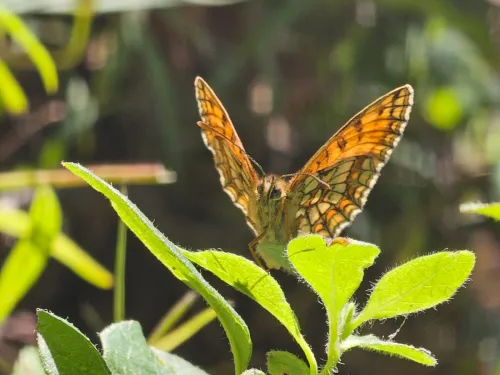
Meet the enchanting heath fritillary butterfly
This rare butterfly relies on wild woodlands - learn more & support its future.
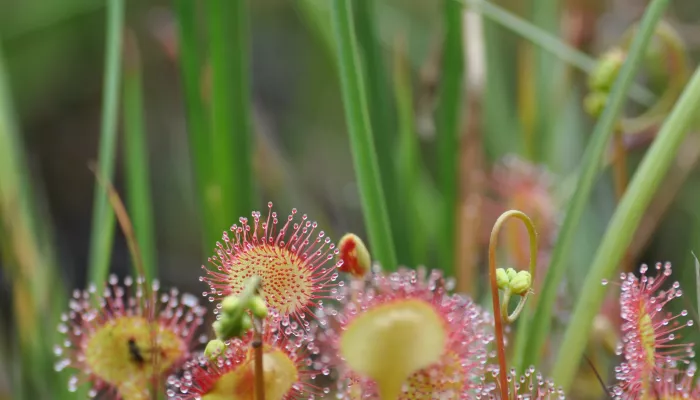
My favourite plant (well for today anyway) on the Heathland will only become obvious from the chilly waters of the upper bog in May. The carnivorous round leaved sundew, Drosera rotundifolia, overwinters as a hibernaculum, a small globe of curled up leaves tucked into the sphagnum moss. As the water warms up a rosette of ground-hugging leaves unfurls to its full 2-inch width and gets to murderous work.
Growing in acid nutrient-poor habitats, its small fibrous root system provides light anchorage but absorbs water, while green fleshy leaves, flower stems and sepals make food through photosynthesis; this is supplemented by the nitrogen-rich soup extracted from the dissolved bodies of insects that are captured by the extremely sensitive long-stalked sticky glands on the leaves. Sarah Raven, in her book Wild Flowers, states that up to 2,000 insects can be caught by one plant in a summer. That’s a lot of supply flights. Although small, the plants are easy to spot from the causeway, tiny patches of reddish green, singly or in glistening colonies. It’s worth using binoculars to observe the plants in detail.
From June through August a wiry stem uncoils from the centre of the rosette, bearing tiny white flowers of six petals all on the same side of the stem, apparently floating a few inches above the plants - the distance enabling pollinators to reach the flowers and avoid the traps below. The flowers open successively, and in poor weather (think Scotland) flowers remain closed and can self-pollinate. The flower stem hardens and the seed capsule persists in autumn as the plant curls back into a hibernaculum. The seeds need a cold winter – stratification – to promote germination.
The common name sundew describes the plants’ appearance, every leaf filament is tipped with a drop of viscid liquid that glistens like dew in the sun, deceiving insects into thinking they are landing on water. Drosera is from the Greek, drosos = dew, dewdrops, rotundifolia describes the round leaves. The other native sundews are great sundew, Drosera anglica and oblong-leaved sundew Drosera intermedia, both scarce species.
They certainly have a rich history. Thomas Culpeper in his Complete Herbal of 1653 noted that ‘the hotter the sun shines, the moister they (the leaves) are’ and recommended using the juice of the leaf to destroy warts and corns. Richard Mabey in his Flora Britannia reports that herbalists promoted the liquid to preserve youth, strength, and vitality. Similarly, workers on the Lancashire peat carrs called it youth grass, and harvested it as a kind of catch crop. In Europe spices were added to make Ros Solis liquor to preserve youthful looks, strength and longevity. The plant’s ability to entrap made it a love charm and in 1968 youngsters stole bits from a specimen in Douglas Museum to put in the pockets of persons they fancied. The collectible 1958 Brooke Bond album of Wild Flowers Series 2, illustrated by Charles Tunnicliffe, includes cards of Drosera rotundifolia and butterwort.
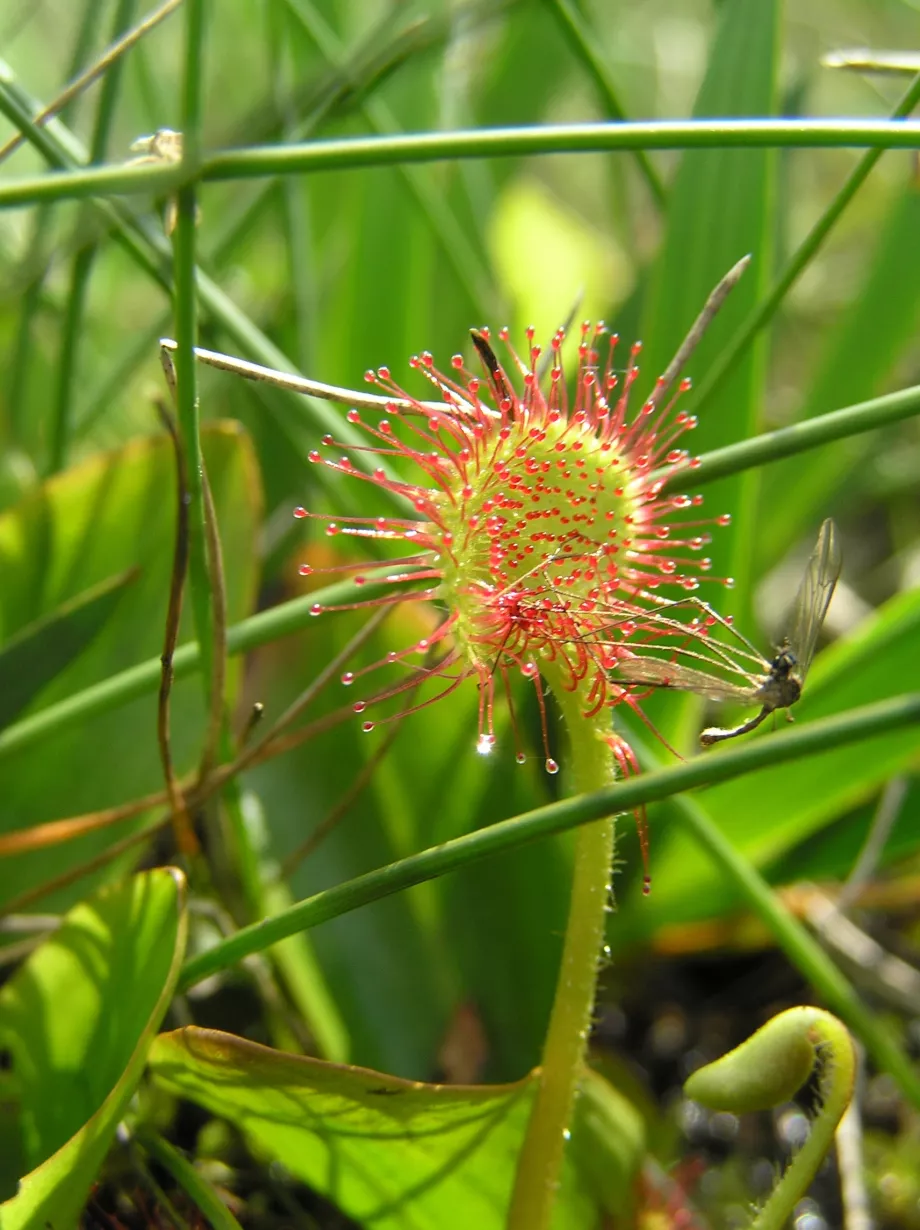
©Ian Rickards
The fact that certain plants trap insects had been recorded by various naturalists across the world. Erasmus Darwin, Charles Darwin’s grandfather, thought that sundew caught insects to prevent them predating on the flowers. It was Charles Darwin who first proved that some plants are carnivorous, trapping and feeding on insects. Darwin recorded sundew and butterwort (Pinguicula) growing in peaty ground in Tierra del Fuego in 1833 during his journey around the world on The Beagle.
In 1860, the year after the publication of On the Origin of Species by means of Natural Selection he first observed insects trapped in the leaves, and movement of the ‘tentacles’ of two of the three British species of sundew, while visiting Hartfield, East Sussex. He wrote ‘This made me think it probable that the insects were caught for some special purpose.’
Looking for more evidence of how plants gradually adapted to different conditions, Darwin started a series of thousands of experiments by himself at his Kent home, Down House, and by his scientific colleagues.
He examined and recorded everything minutely, how tentacles are triggered into trapping an insect, how just one tentacle touched would trigger a reaction, the roles of different tentacles, the time taken to entrap, the more an insect struggled the quicker the capture, the time taken to digest, uncurl, start again, how unabsorbed hard chiton is left to blow off the leaf, the cellular structure and function of the glands, the changing nature of the secretion which, he discovered, produces an antiseptic as well as the gastric juice that turns the insect into nutritious soup, the streaming movement of protoplasm in the cells that provided the movement of the tentacles.
He observed that the leaves only responded fully to material likely to provide nutrition, not to rain, blown leaves or dust, nor the salt, saliva, sugar, soot, hard-boiled egg and other material tried by Darwin, showed that the plant only used energy to preserve itself.
The round leaved sundew was the first subject of Darwin’s 1875 book Insectivorous Plants a detailed study of how adaption by several genera of carnivorous plants to difficult conditions produced change i.e. evolution. On the drosera genus he concluded:
The three most remarkable characters possessed by the several members of the Droseraceae consist in the leaves of some having the power of movement when excited, in their glands secreting a fluid which digests animal matter, and in their absorption of the digested matter.Charles Darwin
and asked
"Can any light be thrown on the steps by which these remarkable powers were gradually acquired?"
There is no need to wait for a socially-distanced book delivery to read Darwin’s account of feeding sundew hard-boiled egg, it can be read online at here.
Mea Allen’s 1977 biography focusses on Darwin and his Flowers.
The sundew family, Droseraceae, is one of the largest of the carnivorous plants, with nearly 200 known species, occurring all round the world, something that Darwin already knew, thanks to courageous explorers and collectors. He would have been intrigued by the modern hybrid, Drosera rotundifolia ‘Charles Darwin’. Round leaved sundew is native in all northern regions, i.e. transboreal.
I myself found it at elevation in chilly acid seepage above the Cypress Bowl ski area north of Vancouver. West Coast First Nations used the leaves to remove warts, corns and bunions; called many hearts by the Haida, they used it as a good luck charm for fishing. More than half the known species occur in Australia.
In dappled or deeply shaded forests in Victoria State, I was thrilled to find several species in a single square yard, some ground hugging with disproportionately large single flowers, some wispy climbers with nodding bell-shaped leaves, all in flower. There were more in the Blue Mountains and on North Head Sanctuary, overlooking crowded Manly beaches, the ferries chugging across to Sydney and humpback whales migrating south, while the few remaining Manly penguins hunted offshore, returning to shore at dusk as the shy bandicoots and pygmy possums emerged to feed.
In New Zealand I saw Drosera arcturi at 2,430 ft. on the Dobson Walk in Arthur’s Pass, and tuberous Drosera auriculata adapted to the hot sulphurous margins of the Rotorua mud pools.
But it is round leaved sundew, his beloved Drosera, that got Darwin experimenting with carnivorous plants. Crossing the upper bog causeway at Hothfield Heathlands we walk alongside what Darwin called ‘a quiet but lethal war’ of highly complex processes, the study of which helped lay the foundations of the modern search for biology’s underlying rules, including plant movement – tropism – and the development of hormone rooting powder.
How lucky we are to have this plant protected here, as it is well out of its main areas of occurrence in the UK because of habitat loss. Elsewhere, peat extraction is still destroying the sundew habitat. Site of Special Scientific Interest (SSSI) designations and the work of Wildlife Trusts reflect the urgent need to protect the original wild inhabitants of these spaces.

This rare butterfly relies on wild woodlands - learn more & support its future.
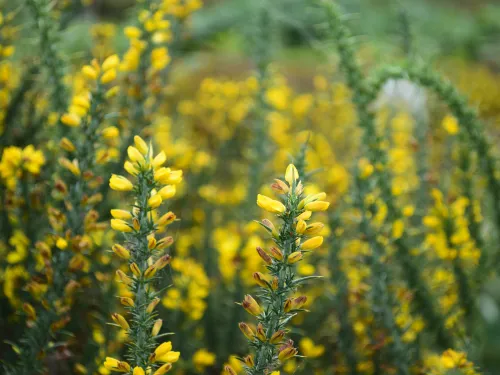
Long-time volunteer Margery Thomas explores what Hothfield Heathlands is like on a crisp November day.
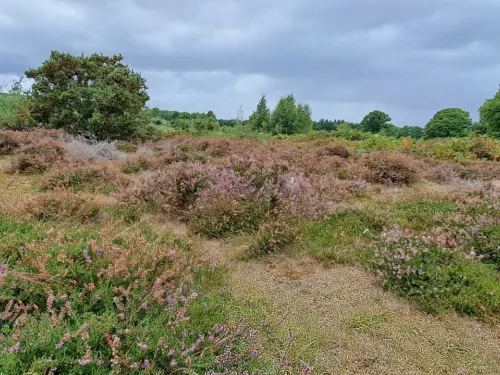
Area Manager, Ian Rickards, takes a moment to reflect on the work at Hothfield Heathlads throughout the summer months.